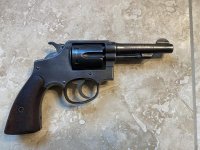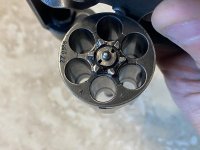were the guns in the Feb 1945 shipment the only SV serial guns?
how many did S&W make?
The SV numbers started in December 1944, as mentioned above. It continued after the war up to about the SV813000 range. After SV811119, S&W introduced the simple S prefix (S811120), but there were quite a few SV serialized revolvers produced up to the 813000 range, when the V disappears permanently and from that point on, they just had the S prefix until the numbers ran out at S999999 and the C prefix began. That happened in March 1948.
No one knows exactly how many units carried the SV prefix, but the lowest number I've found is SV732261 (a Navy gun that shipped on July 29, 1945). The highest is SV813132, but there are S prefix guns with lower serial numbers than that. Hence, we can't just subtract 732261 from 813132 to get the total number.
What we do know is that SV769844 was in a postwar civilian shipment on March 22, 1946, even though higher numbers were shipped to the Navy before the war ended. After SV802722 on August 13, 1945, there were no more military shipments. All of them above that number were civilian shipments after the war.
We can therefore conclude that a large number of SV prefix guns were in postwar shipments to distributors, gun shops and police departments after WWII ended.
What would have been the stocks that would have shipped on this gun?
The standard military stocks during WWII. They had no checking and no medallion. I've attached a photo.










